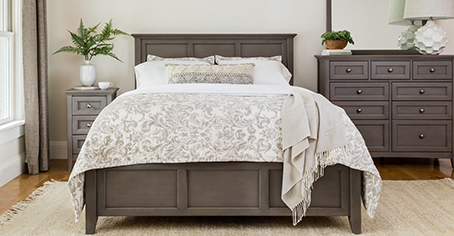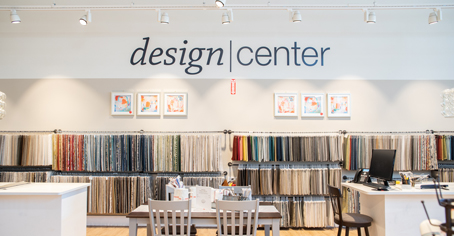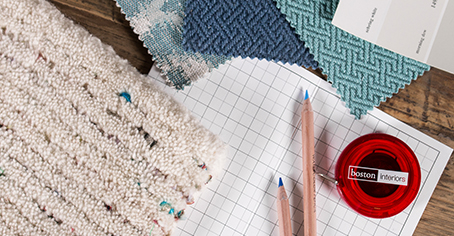This website uses cookies to improve user experience and analyze web traffic. By clicking "Allow Cookies" you consent to store on your device all the technologies as described in our Cookie Policy. Learn more.
Furniture Care
Furniture Care
Your furniture and your floors:
Even the most finely finished furniture can be damaged if not protected. We highly recommend that you attach felt disc pads (available at your local hardware store) to the bottom of each leg on all furniture you plan to place on hardwood or wood laminate flooring.
How to minimize wear and tear:
As no finish is fully unscratchable, and everyday items like keyboards, pets, alarm clocks and lamps can damage your furniture's finish, it's also smart to put the same kind of felt discs on the bottom of items in regular contact with your new furniture. And speaking of your furniture's finish, remember some of the chemicals in common products can soften your furniture's finish coat and cause dents and discolorations. So read all labels before using any chemical cleaners.
Maintaining your new upholstery:
All upholstered furniture needs some regular maintenance. So if you want to keep that "showroom" look, plan to fluff and rotate any loose seat and back cushions at least once a week. And remember, while most casual pieces will conform to one's shape over time, you can minimize this effect by regularly fluffing the fiber or down filling and redistributing it more evenly. Also, do remember that while some of your cushions may feel very firm on their day of delivery, they will soften and settle with time. To maintain the beauty of your furniture's fabric, we recommend you vacuum it regularly. But be sure to use the correct brush attachment and ensure it's lint-free before you make contact with the furniture. Another good idea is to place furniture cups under all legs to protect your carpet and pad and ensure skirted furniture fabrics stay off the floor.
Upholstery accidents and professional cleaning:
If an accident occurs and you purchased the Guardsman Protection Plan through Boston Interiors: Notify Guardsman within five business days of a stain or damage occurance. Contact Guardsman at 1-800-253-3957 to request service for the stain or damage. Have your furniture sales receipt and the protection plan number ready. If an accident occurs and you did not purchase the Guardsman Protection Plan, we recommend you have it professionally cleaned. But whether you hire a professional or you do it yourself, be sure to follow industry standard cleaning methods or your furniture could be ruined. This means not using water to clean spills or stains unless it is indicated as "safe" on the fabric code usually found on the law tag under the seat cushions. These codes are explained here:
- W: Use water-based cleaning agents (distilled water) or foam but never tap water as its minerals may cause rings or fading
- S: Only mild, water-free cleaning solvents should be used. Never use water. Do not dry clean in parts
- WS: Use water-based cleaning agents, foam or mild water-free cleaning solvents but never tap water as its minerals may cause rings or fading
- X: Clean only by vacuuming or light brushing to remove overall soil. Never use water, foam or liquid cleaning agents
Always pre-test cleaning agents in a small, inconspicuous area before proceeding. When cleaning a spill, blot immediately to remove spilled material, use a clean white cloth,work from the outside to the middle of the affected area to prevent rings and never rub or use strong chemicals or detergents.
Washable Pre-washed Slipcovers:
Even if you have a washable slipcover you may want to have it professionally dry cleaned. The body slipcover of a sofa is a fairly bulky load, requiring a "laundromat" type of washer. Should you choose to wash your slipcover, follow these instructions.
- We suggest that you run the washer through a wash cycle empty before washing your slipcover -- just to be sure it is free of any detergent, bleach, or other impurities that might spot or stain the slipcover.
- We also suggest that you wash the entire slipcover; washing only select parts may result in color variations on the piece of furniture (you may want to consider washing all pieces in the collection at the same time, i.e., wash the sofa, the chair and the ottoman covers at the same time -- again, to minimize color variations which may occur with washing).
- Don't overload your washer. Separate the slipcover into two loads, washing the body cover in the first load and the cushion covers in the second load.
- Zip the zippers (closed) on pillow and cushion covers to prevent damage when washing.
- Use the gentle cycle on your washing machine. Use cold water and a mild detergent. Do not use a detergent with bleach or a bleach additive.
- Remove the slipcover from the washer immediately at the end of the cycle. While air-drying is preferred, you can use the dryer - on the NO HEAT setting. Tumble dry until the slipcover is just slightly damp.
- Put the Body slipcover back on the piece of furniture while still slightly damp - you may need to stretch it a little to get it back on. Putting the cover back on while it's still slightly damp ensures it will dry to fit.
- Covers for the seat and back cushions and pillows should be replaced slightly damp as well. Stand the cushions on end, rotating them every 20 to 30 minutes until dry. This will prevent any water that may drain to one side of the cushion from sitting in one place and possibly causing a water stain.
- Not all slipovers are prewashed and washable. Please check manufacturers cleaning instructions, fabric content and cleaning codes before attempting to clean your slipcover.
Fading:
All fabrics fade over time. But how fast they do so is largely determined by your fabric content, its color, and most importantly, the amount of direct sunlight your piece is exposed to. Cotton and primary colors show fading the fastest. Since fading is not covered by manufacturers' warranties and you want your fabric to look great for as long as possible, always avoid placing your furniture in direct sunlight. Sunbrella fabrics are also recommended for rooms with intense light.
Pilling:
Fabric pilling is absolutely normal. It can be easily controlled with a fabric shaver (available at most fabric and craft stores). What's more, consistent use of a fabric shaver will actually cause the fabric to stop pilling and do so without affecting the fabric's performance or longevity.
Performance Fabrics
Two of our most popular and highest quality performance fabrics include Sunbrella® and Crypton. Each require a different care plan from other fabrics.
Sunbrella®
One of the best ways to maintain Sunbrella® fabrics is to brush off dirt before it becomes embedded and to wipe up/clean spills soon after a stain occurs. Quicker cleanup=more easily removed.
- Blot (don't rub) liquid spills with a clean, dry cloth. For oi-based spills, apply an absorbent such as corn starch. Remove with a straight edge.
- Spray on a mild cleaning solution of soap and water.
- Rinse fabric thoroughly to remove all soap residue and air dry.
- See further care instructions.
For light to medium stains, spot cleaning can be used.
- Prepare a cleaning solution of 1/4 tsp mild, enzyme detergent, such as Tide®, Woolite® or Dawn® dishwashing liquid, per 1 cup of lukewarm water.
- Apply the cleaning solution using a misting spray bottle.
- Work the solution into the affected area by lightly scrubbing the area with a sponge or soft bristle brush. Make sure to work from the outside of the stain inward so as not to spread the stain and rinse your sponge or brush frequently.
- Allow cleaning solution to soak into the fabric.
- Rinse thoroughly to remove all soap residues, as residues will attract dirt. Blot excess moisture with a clean, soft towel or sponge.
- Repeat steps 3-6 as needed.
- Allow fabric to air dry.
- Before spot cleaning, blot up liquids on the surface with a clean, soft towel and brush off any loose dirt.
- See further care instructions.
Leather
It takes several hides to make one piece of upholstery. For this reason, there will be variation in color and in natural markings on the same item. These variations are considered a desireable characteristic of the product and are not defects.
Leather upholstery requires the same care as fabric upholstery in terms of the cushion care:
- Fluff and rotate any loose seat and back cushions at least once a week
- Leather can fade so it should be kept out of direct sunlight
- Condition at least twice a year to prevent your leather from drying out our cracking
- Dust regularly with a dry cloth and vacuum as needed
- Blot liquid spills immediately with a clean, absorbent cloth or sponge
Cleaning and conditioning methods will depend on the type of leather purchased. Check your leather type; analine/protected leather, wax pull up leather, oil pull up leather, or nubuck leather prior to cleaning or conditioning to ensure you have the appropriate product
Characteristics of real wood furniture:
Every piece of real wood furniture has its own characteristics. It expands and contracts with changes in humidity and temperature. Drawers can tighten in the summer and loosen in the winter. Its grain and color are just different enough to be unlike any other piece in the world. In short, every piece of real wood furniture is one-of-a-kind and more beautiful because of it.
Wood care:
Heat and spills can damage the finish coat on a table. As a general rule, use tablecloths or placemats when dining, use coasters under drinks, place well made trivets under all serving dishes (especially hot ones) and always wipe up spills immediately.
Wood cleaning:
We recommend cleaning your wood furniture with a clean, lint-free, barely damp cloth. Tough, sticky spots may require a bit of mild soap, but always perform a final sweep with a dry clean cloth.
Wood maintainance:
A high quality furniture polish can be applied 2 to 3 times each year, however always read the label before using any polish to ensure the polish is safe to use with your furniture's finish (painted furniture can be damaged by polishes). Always store table leaves flat as they can warp if placed on their sides.
Rugs:
To get the most of your rug use a rug pad and turn your carpet 180 degrees once or twice a year to ensure even wear. Vacuum it regularly but avoid damaging any fringe. Never use a beater bar on a hooked rug. All spills should be blotted immediately with a white cloth and soda water. Do not rub. Shedding is normal and can continue up to 6 months. Longer yarns commonly work loose from a hooked rug's backing and should be trimmed with a pair of sharp scissors.
Bedding:
Our mattresses do not require any rotation or flipping. All are one sided products. Some do have a head end and a foot end. This is indicated by the lack of quilt buttons on the head end. Body indentations are normal and are more evident on mattresses with plush or pillow tops. Do not bend your mattress more than 20 degrees or you may cause harm to the spring unit which is not covered under warranty. Mattress pads are a good idea for any product that lacks a zip on/zip off topper.
Safety:
We require all of our manufacturers to follow U.S. safety regulations in product manufacturing regardless of where the product is made. Please note: While products sold should be tip-proof—specifically bedroom dressers, tall shelving, or other large pieces of furniture—out of an abundance of caution Boston Interiors suggests using a “tip kit.” This will secure these large pieces to the wall and help prevent tipping. One of these tip kits will be provided with your furniture upon delivery. If for any reason you did not receive a tip kit, or you would like to request a complimentary kit, please contact our customer service department at 1-781-847-4600.











